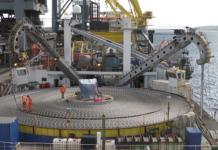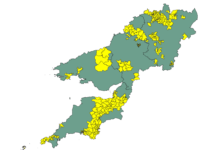 The increased sophistication of PDUs is in line with expectations for increasingly granular data. Panduit’s Sander Kaempfer provides an insight into the role of intelligent technologies in the data centre and the scope for smart PDUs
The increased sophistication of PDUs is in line with expectations for increasingly granular data. Panduit’s Sander Kaempfer provides an insight into the role of intelligent technologies in the data centre and the scope for smart PDUs
Power demands at data centres continue to grow, with the number of global sites increasing steadily and medium-sized sites requiring up to 8MW, guaranteed supply from the grid and significant investment in redundant primary switchgear, together with the assortment of power generators and UPS to ensure the IT environment provides continuous uptime.
Those are the big numbers but what about at the cabinet level power distribution?
Innovations in power distribution units, what some are calling intelligent PDUs, are creating live systems that are generating actionable data. ‘Take care of the pennies and the pounds take care of themselves,’ is a highly relatable idiom for anyone designing power distribution infrastructure for a data centre.
One of the largest operational expenses for a data centre is energy. It is estimated that on average 27% of ongoing costs are on power, and operators and customers want as much of that energy as possible to be used by productive IT systems.
How do we do this when IT load has become less predictable, with massive change in usage driven by the growth of mobile data, IoT and media?
Factors driving interest in intelligent or smart PDUs include the increasing demand for high-power capacities in high-density compute environments and rising demand for intelligent infrastructure products in data centres.
This increase in server density in the racks is key to the intelligent PDU market, which was valued at $1.20bn (£910m) in 2016 and is expected to reach $2bn (£760m) by 2023, illustrating the industry’s drive to acquire systems that can positively integrate into managed IT environments. In the same period, the high density rack server market will grow from $36.5bn (£27.7bn) in 2016 to $90.56bn (£68.8bn).
PUE metric: tick box or key achievement?
The Green Grid developed the power usage effectiveness (PUE) metric more than 10 years ago. This is a ratio of total annualised facility energy use against total IT energy use, and provides the market with a comparative measure of the data centres energy efficiency.
The industry’s average PUE for a medium-sized facility is 1.7, and there is momentum within the industry to design and build sites with PUE of about 1.2-1.4 (for example, Kao Data London One data centre site has a PUE of <1.2).
A key route to reducing energy use in the compute area is to accurately measure, analyse and control power to the heart of the white space. Taking an increasingly granular view of IT power use through rack-mounted intelligent PDUs and their management systems allows operators and customers to control the IT environment in a way not previously available.
Even with the growth in high-density servers and the additional power draw on a per rack basis, the control now available can substantially lower the overall power requirement of the customer’s computing load.
The need for remote power monitoring and management has been driven by the change in strategy in enterprise computing, and the growing use of colocation by the enterprise market, and has now become an essential requirement for many organisations, as part of Cloud or hybrid IT strategies.
The latest generation intelligent PDUs offer sophisticated features at the rack-level, which can automatically gather and analyse granular data by monitoring software. Energy metering and monitoring provides watt-hour energy billing capabilities, accurate enough for customer billing, while outlet metering offers information required for Green Grid Level 3 PUE calculations.
Input-metered PDUs determine the available capacity of the racks, and outlet-metering determines the available capacity to facilitate system provisioning. User-defined criteria allow input-metered PDUs to trigger alarms, providing warnings about potential circuit overload, therefore eliminating most IT failure scenarios, while outlet-metered PDUs are used to measure the actual consumption of power at the device and server levels, a requirement in colocation facilities where multiple customers can share cabinet space.
Measurement and control
Rack PDUs that have the ability for outlet level power monitoring and outlet level switching capabilities for individual outlets or a group of outlets have the capability to identify idle servers that are still consuming power without contributing to the IT load, these are often called zombie servers. This capability provides management with the data to consolidate applications across fewer servers, reducing overall power use and increasing cost efficiency.
Power monitoring at the individual outlet level provides increased amounts of actionable management data on the power consumption of each connected IT device enabling the redeployment or decommissioning of individual servers, storage or switches to reclaim under utilised power capacity.

Smart PDUs offer the ability to control individual outlets, allowing remote rebooting of IT equipment if necessary, and power sequencing to ensure power fluctuation and surges are eliminated during shutdown or power up. This will improve problem resolution response time and, in many cases, reduce the requirement for physical technical support to attend an incident.
New developments have created PDUs with high temperature grade components to operate up to 60oC for extended periods, which work within the latest Ashrae 9.9 guidelines allowing servers to be operated up to their manufacturer’s optimised performance temperatures. These highly reliable power systems can monitor and detect power fluctuations and implement phased reductions and shutdowns on individual or groups of servers, and raise alarms and notifications if manual intervention is required.
The increased sophistication of the PDU is in line with expectations for increasingly granular data that is being monitored and analysed around the system.
Standard PDUs are not designed to integrate with data centre information management systems. Hyperscale level environments, or greenfield data centres being developed to those levels of sophistication, need the capacity to interrogate compute and environmental systems at the rack, in order to optimise control of the total system.
 This is an important element in the challenge to be flexible to customer requirements, while maintaining a policy of increased energy efficiency and site productivity. As the cost of data centres increases and the environment become more complex, with taller cabinets, increased numbers of servers, operating at high temperatures, intelligent PDUs will become increasingly integrated with more of the smart infrastructure.
This is an important element in the challenge to be flexible to customer requirements, while maintaining a policy of increased energy efficiency and site productivity. As the cost of data centres increases and the environment become more complex, with taller cabinets, increased numbers of servers, operating at high temperatures, intelligent PDUs will become increasingly integrated with more of the smart infrastructure.
Control of energy use is the largest potential cost saving available to the data centre operator. The increasingly sophisticated smart technologies being incorporated into building infrastructure are designed to access massive amounts of data, analyse it in real-time and take actions to mitigate potential incidents. This growth in operational data analysis ensures reduce overall cost reductions and positively effects the continuous reduction in the PUE measurement, while maximising individual customer information.



